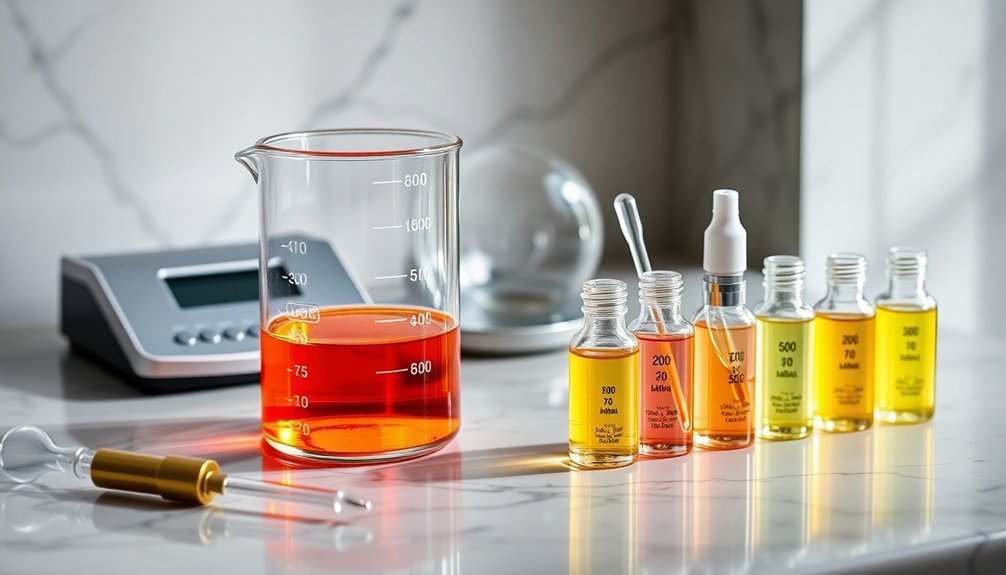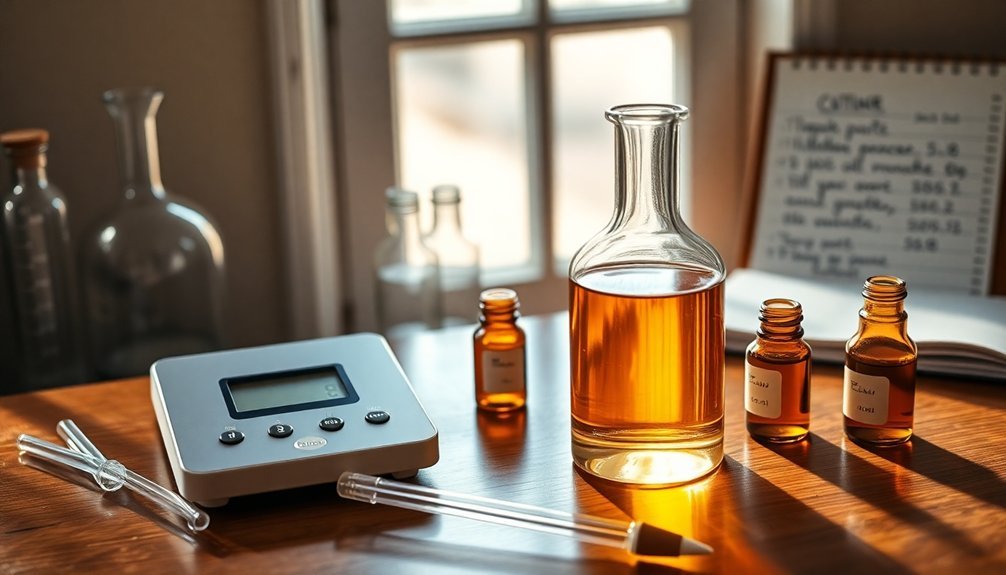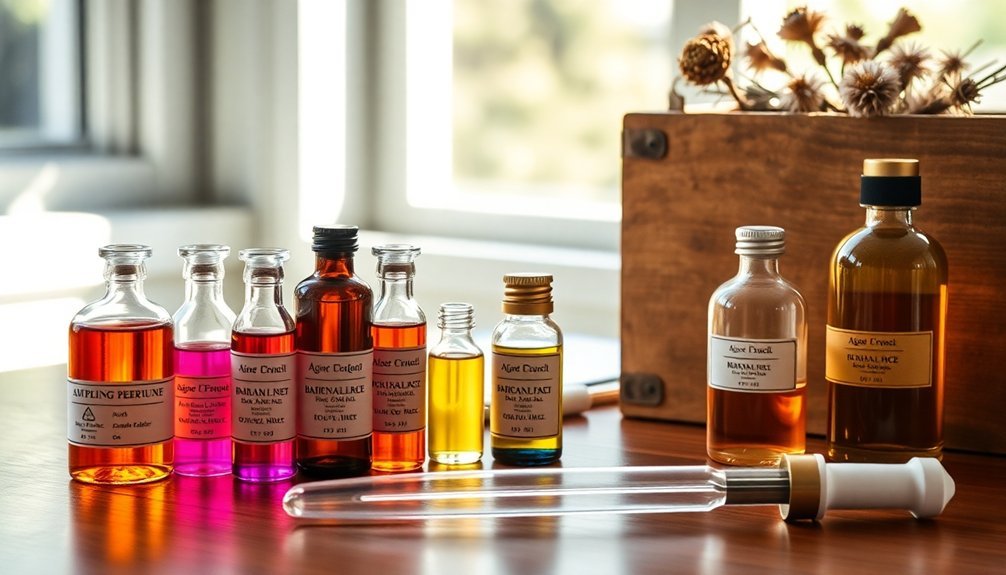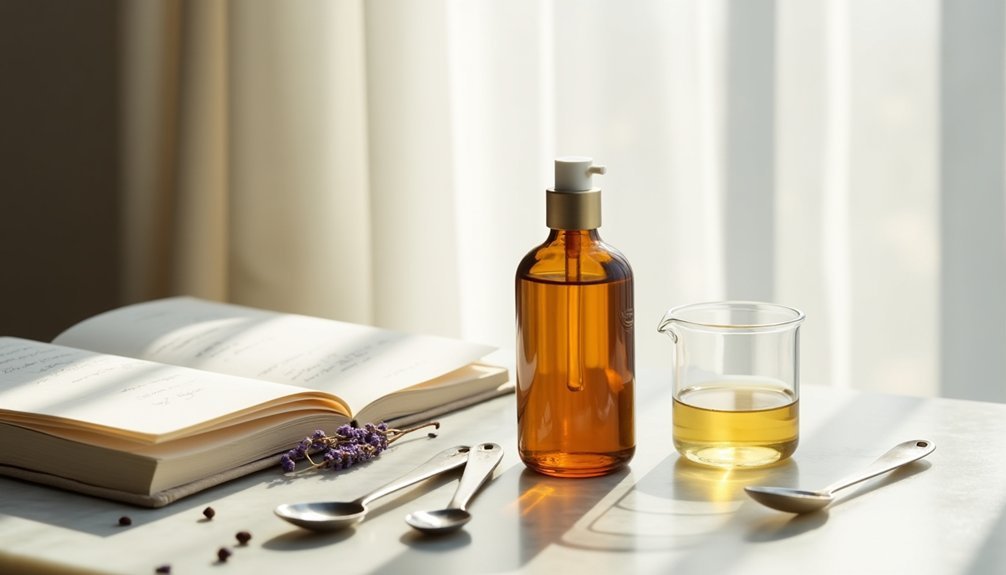To dilute fragrance oils safely, you'll need to follow proper concentration ratios – 10-20% for synthetic fragrances and 1-3% for essential oils. Start with a precise scale measuring to 0.01g and quality carrier oils like jojoba or fractionated coconut oil. Mix your oils in dark glass containers using proper calculations, not drop counting. Always conduct patch tests before full application. The art of perfect dilution involves many more essential steps and techniques to master.
Understanding Dilution Ratios and Percentages

When working with fragrance oils, understanding proper dilution ratios is crucial for both safety and effectiveness.
You'll need to determine whether you're using essential oils or synthetic fragrances, as they require different dilution levels. Essential oils are more concentrated and typically need 1-3% dilution, while synthetic fragrances can handle higher ratios of 10-20%.
For personal care products, you'll want to follow these general guidelines: facial products should use 1% or less dilution, body oils and massage products can use 1.5-3%, and rinse-off products may allow slightly higher concentrations. Using carrier oils like jojoba provides an ideal base for safe dilution and application.
To calculate the proper ratio, you'll need to weigh both your fragrance and carrier oils precisely. Remember to always patch test your diluted mixture to guarantee skin compatibility before full application.
Essential Tools and Materials for Diluting Oils
You'll need precise measuring tools like scales accurate to 0.01g, measuring cups, and pipettes to create accurate fragrance dilutions.
Keep your supplies organized with glass beakers, dropper bottles, and spatulas for handling different materials, from liquid oils to solid powders.
Store your diluted fragrances in properly labeled containers, and maintain a clean workspace with documentation tools to track your formulations. Consider using perfumers alcohol for most dilutions, as it's an ideal carrier for alcohol-based perfume sprays.
Basic Equipment List Needed
Success in diluting fragrance oils starts with having the right equipment on hand.
You'll need various glass containers, including beakers for mixing, bottles for storage, and dropper bottles for precise measurements. Essential measuring tools include spatulas for powders, pipettes for liquids, and an accurate scale or lab balance.
For the dilution process, you'll require key solvents like perfumer's alcohol, DPG, and benzyl benzoate. When mixing, adding alcohol to approximately two-thirds of the container helps achieve proper dilution ratios.
Don't forget to set up a water bath for warming thick materials. Safety equipment is vital – always keep protective gloves and goggles nearby.
To maintain organization and prevent contamination, use a label maker for identifying your dilutions and guarantee you're working in a well-ventilated space with a clean workstation.
A calculator or perfumery app will help you make accurate dilution calculations.
Measuring Tools For Precision
Three essential measuring tools form the foundation of precise fragrance oil dilution: a high-accuracy scale, reliable pipettes, and proper calculation tools.
You'll need a scale that measures to 0.01g, ideally a jewelry or lab balance, for accurate measurements. Remember to tare your scale before weighing materials in glass beakers or dropper bottles.
For calculations, you'll want to work with weight-based measurements rather than volume. Use a calculator or perfumery app to determine your ratios, following standard dilution formulas like 1:9 for 10% solutions.
While pipettes help measure liquid materials precisely, avoid relying on drop counts. Instead, weigh everything on your scale for consistency.
Don't forget to label your containers immediately after filling and keep your spatulas and beakers clean for accurate measurements.
Storage Containers And Supplies
Beyond precise measurements, proper storage containers and supplies make all the difference in maintaining your diluted fragrance oils.
You'll need dark glass bottles to protect your blends from light exposure, guaranteeing their scents remain intact. While plastic containers like HDPE or PET work for diluted oils, they're not suitable for undiluted versions.
For diluting, you'll require neutral carrier oils such as jojoba or sweet almond, especially for aromatherapy applications. If you're creating alcohol-based perfumes, perfumer's alcohol is your go-to diluant.
Keep DPG on hand for hard-to-blend materials. Don't forget essential tools like glass beakers, pipettes for precise measurements, and spatulas for handling solid materials.
Always label your containers with dilution ratios and contents. Ascertain your bottles have enough space for easy mixing and proper preservation.
Selecting the Right Carrier for Your Fragrance
Choosing the right carrier oil forms the foundation of a successful fragrance dilution. You'll want to take into account your skin type, scent compatibility, absorption rate, and longevity when selecting your carrier.
| Carrier Oil | Best For |
|---|---|
| Jojoba | All skin types, neutral scent |
| Grapeseed | Oily skin, quick absorption |
| Sweet Almond | Sensitive skin, subtle notes |
| Fractionated Coconut | Fast absorption, longevity |
For daytime fragrances, opt for lightweight carriers like grapeseed or fractionated coconut oil that absorb quickly. If you're creating evening perfumes, think about richer options like apricot kernel or argan oil. Those with sensitive skin should stick to sweet almond oil, while jojoba works universally well due to its similarity to natural skin oils. Remember that your carrier's scent profile can either enhance or compete with your fragrance oils.
Step-by-Step Dilution Process

Diluting fragrance oils requires precision and attention to detail to achieve the perfect balance of scent and safety. Start by selecting your dilution ratio based on the oil's potency and intended use – 1-3% for personal care products or 0.5-1% for room sprays.
- Gather a clean, dark glass bottle and precise measuring tools.
- Measure your carrier oil first, pouring it into the container.
- Add fragrance oil drops slowly, counting carefully to maintain ratio.
- Secure the cap tightly and gently roll the bottle between your palms.
- Let the mixture sit for 24-48 hours to allow scents to blend.
Remember to conduct a patch test before using your diluted fragrance.
You'll want to document your ratios and ingredients for future reference, making adjustments based on your preferences and testing results.
Common Dilution Mistakes to Avoid
While making fragrance dilutions can seem straightforward, even experienced crafters stumble into common pitfalls that compromise their final product.
You'll want to avoid using excessive concentrations of fragrance oils, as this can cause skin irritation and overpowering scents. Stick to 1-3% for skin products and 0.5-1% for room sprays.
Don't rely on carrier oils when perfumer's alcohol is the better choice for evaluating fragrances.
You'll also need emulsifiers for water-based dilutions since oil and water don't mix naturally. Always conduct patch tests to prevent allergic reactions, especially with new blends or concentrated oils.
Most importantly, ditch the "drop counting" method. Use a precise scale to measure your ingredients – this guarantees accuracy and reproducibility in your formulations.
Proper Storage and Aging Methods

After mastering the proper dilution techniques, you'll need to focus on storing your fragrance oils correctly to maintain their quality.
Keep your oils at room temperature between 65°F to 85°F in a cool, dry space away from direct sunlight and heat sources. Dark glass bottles are your best friend – choose amber or cobalt containers to protect against UV damage.
To maximize shelf life and guarantee proper aging, consider these essential practices:
- Store bottles in a dedicated drawer or cupboard away from temperature fluctuations
- Transfer oils to smaller containers as you use them to reduce oxygen exposure
- Label each bottle with the "opened-on" date to track oxidation
- Always secure bottle caps tightly after each use
- Allow your custom blends to mature undisturbed for ideal scent development
Testing and Adjusting Your Diluted Blend
You'll need to assess your diluted fragrance blend through multiple testing phases to understand how the scent evolves over time.
Testing strips can help you track the initial, middle, and base notes as they develop, while small batch testing in different mediums reveals how your dilution performs in real applications.
Based on your observations, make precise adjustments to your dilution ratios until you achieve the desired scent strength and longevity.
Evaluating Scent Over Time
Once you've created your diluted fragrance blend, testing its performance over time becomes essential for achieving the perfect scent.
Apply a drop of your blend to fragrance test strips and evaluate how the aroma evolves throughout the day. You'll want to assess the scent at key intervals to understand its progression.
- Watch how the bright top notes dance in the first few minutes
- Notice the heart notes emerging after 30 minutes
- Experience the base notes settling in after several hours
- Observe how the overall blend harmonizes over time
- Feel the subtle changes as the scent matures on your skin
Let your blend mature for at least a week before making final adjustments.
This resting period allows the fragrance molecules to meld together, creating a more balanced and refined scent profile.
Balancing Dilution Adjustments
Testing and adjusting your diluted fragrance blend requires a methodical approach to achieve the perfect balance. Start by performing a patch test on a small area of skin to check for sensitivity. Then, make incremental adjustments to your blend using precise measuring tools, always documenting your changes.
| Adjustment Type | Action Steps |
|---|---|
| Initial Dilution | Start with 1-3% for essential oils, 10-20% for synthetic fragrances |
| Carrier Oil | Add small amounts to reduce strength |
| Fragrance Oil | Increase gradually for stronger scent |
| Final Testing | Allow blend to mature, then test on skin |
Remember to take into account your intended application when making adjustments. Personal care products typically need different ratios than room sprays. Once you've achieved your desired scent, store your creation in dark glass bottles and let it mature for several days to enhance the fragrance profile.
Frequently Asked Questions
Can I Mix Different Carrier Oils for Diluting a Single Fragrance?
Yes, you can mix different carrier oils for your fragrance. Make sure you consider each oil's properties and scent profile. You'll want to test combinations first and maintain proper dilution ratios for safety.
How Do I Know if My Fragrance Oil Has Gone Bad?
You'll notice your fragrance oil has gone bad if it's darker than usual, appears cloudy, develops sediment, or has a sour/metallic smell. The scent may also be weaker or different from its original form.
Will Diluting Affect How Long My Perfume Stays on Skin?
Yes, dilution affects your perfume's longevity. If you dilute properly, you'll maintain a balanced scent. Over-diluting weakens staying power, while under-diluting won't help it last longer on your skin.
Can I Use Vodka Instead of Perfumer's Alcohol for Dilution?
You shouldn't use vodka instead of perfumer's alcohol. It's lower proof won't properly dissolve fragrance oils, can irritate your skin, and won't provide the same scent stability or longevity as proper perfumer's alcohol.
Should I Filter My Diluted Fragrance Oils Before Bottling?
You don't always need to filter diluted fragrance oils. If your mixture is clear and free of visible particles, skip filtering. However, if you notice sediment or cloudiness, use a 0.5-1.0 micron filter.
In Summary
Creating custom perfumes from fragrance oils isn't difficult once you've mastered proper dilution techniques. You'll find that careful measurements, quality carriers, and proper storage make all the difference in your final product. Remember to start with conservative dilution ratios and adjust gradually until you achieve your desired scent strength. With practice and patience, you'll be crafting unique, perfectly balanced fragrances that'll last.





Leave a Reply